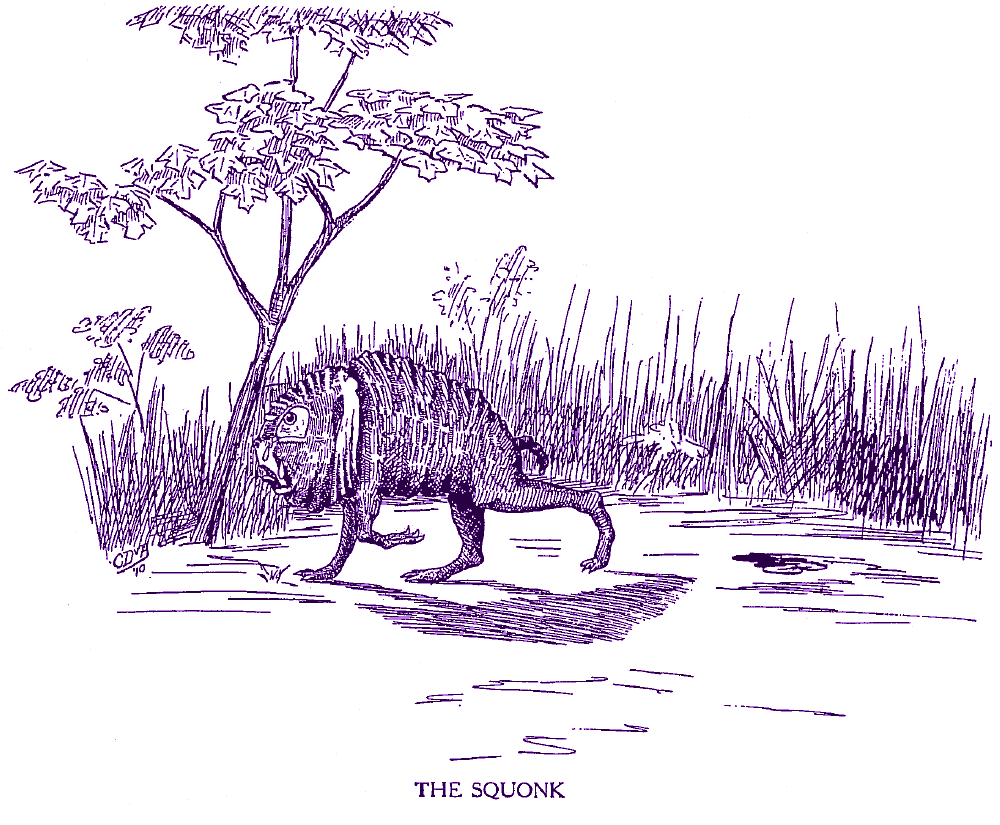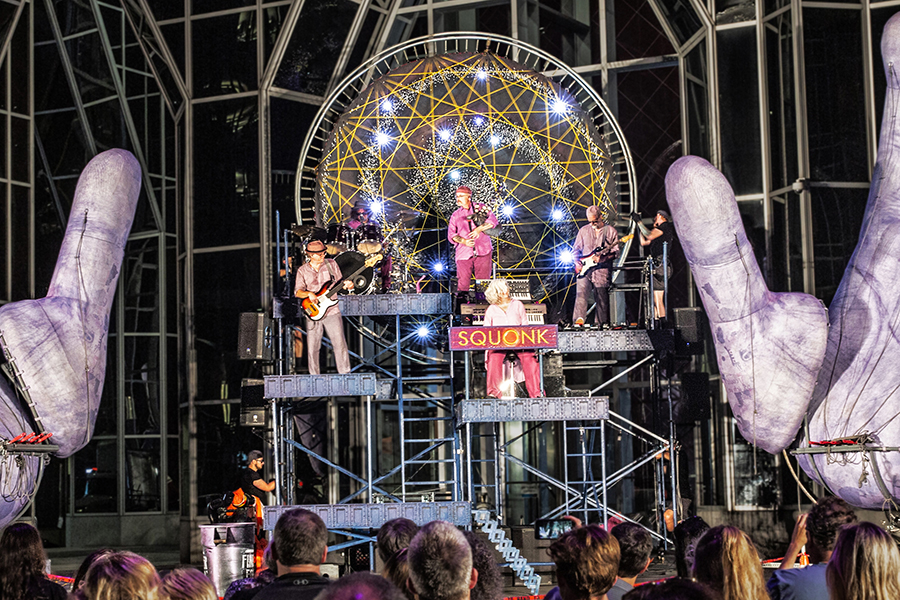
Creating Uncommon Spectacles
Carnegie Mellon alumnus has opened minds and brought art to unusual places for more than three decades
By Tina Tuminella
Steve O’Hearn creates spectacles. For 30 years, the 1995 College of Fine Arts graduate has invented and dreamed, and has no intention of stopping either any time soon.
While attending Carnegie Mellon in the 1990s, Steve formed SQUONK, a Pittsburgh-based performing arts troupe known for whimsical musical spectacles presented in public spaces. He launched SQUONK not just to entertain but also to democratize art.
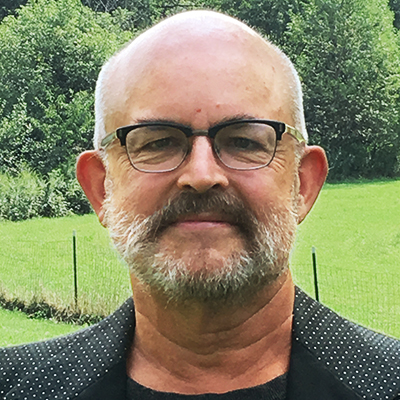 SQUONK has created 14 multimedia productions and has toured extensively in the United States, Europe and Asia. Armed with an MFA in costume and scene design, his passion for art has taken him from Broadway to Hollywood — with stops in 35 states and three continents. Three decades after SQUONK’s inception, Steve and his co-artistic executive director and fellow artist Jackie Dempsey still relish challenging the status quo.
SQUONK has created 14 multimedia productions and has toured extensively in the United States, Europe and Asia. Armed with an MFA in costume and scene design, his passion for art has taken him from Broadway to Hollywood — with stops in 35 states and three continents. Three decades after SQUONK’s inception, Steve and his co-artistic executive director and fellow artist Jackie Dempsey still relish challenging the status quo.
“When we started out, we played a lot of outdoor, free festivals," Jackie says. "Then, we did theatre shows which, while great, are tough because you’re playing to an audience with expectations. There is a financial and behavioral barrier that isn’t found with an outdoor performance. There tends to be more of a mixed audience in outdoor, free shows."
"It’s fantastic to watch grannies dancing with their grandkids, alongside hipsters — people of all ages, all races and different economic backgrounds. There’s an intense energy and joy — seeing everyone all together, having a great time. It can be very transformative for both the audience and performers.”
True Originals
The shows that Steve and Jackie produce are 100% completely original — never an interpretation of a pre-existing work. Steve explains that SQUONK works under the assumption that their art needs to be idiosyncratic and singular in order to be of value. In other words, it needs to be different from what everyone else is doing. Squonk is also a group, which means they are inherently collaborative.
“It just wouldn’t be SQUONK if it weren’t for me and Steve together," Jackie explains. "We’re trained in different things — me in music and Steve in visual arts — and the music needs the visual and the visual needs the music. So it just wouldn’t be what it is without those two things together.”
“Personality-wise, we are very different. I’m more detail-oriented, and he’s more big picture. You need both those things to make something come to fruition. We both have strong opinions about the other’s specialty, which makes it interesting and contentious sometimes, but in the end we come up with the best show. We are both really optimistic, and I believe that’s the biggest reason we’ve [lasted] this long.”
Steve adds that working with Jackie is a real joy.
“We have a strong belief in what we call ‘the expert in the naive opinion.’ There’s a back and forth; I love hearing what musicians think of my design, and I feel free to comment on their music,” Steve says. “Expertise is not the only legitimate way to judge, edit or advance art. It’s also about how it’s seen by people who don’t know anything about the subject.”
Seeing is Believing
It’s impossible to sum up a typical SQUONK experience. Their first show took place in a Pittsburgh junkyard with cranes, earthmovers and machine shears. Another time, they turned Pittsburgh native George Romero’s classic “Night of the Living Dead” into an opera. Other SQUONK shows include such eclectic titles as “Cycle Sonic,” “Firedogs,” “Pneumatica,” “Mayhem and Majesty,” “Astro-Rama,” “Bismorgasbord Wunderwerk,” “Inferno” and “Rodeo Smackdown.” Various subjects tackled on their kinetic sets are bicycles, UFOs, mazes, madness — with an ongoing interest in dichotomies, mass consumption and environmental degradation.
In each production, you will find sound, music, robotics, lighting, staging and choreography, but what is unique is the reliance on all these nonverbal elements generating a cumulative effect.
“I think the main thing that makes [a show] engaging is that you have to participate,” Steve explains. “There’s no storyline or plot to hit you over the head or even characters to follow. We’re just who we are doing stuff. I think there’s a demand for participation that lives in rich contrast to TV and movies, where there’s a zillion stories all the time.”
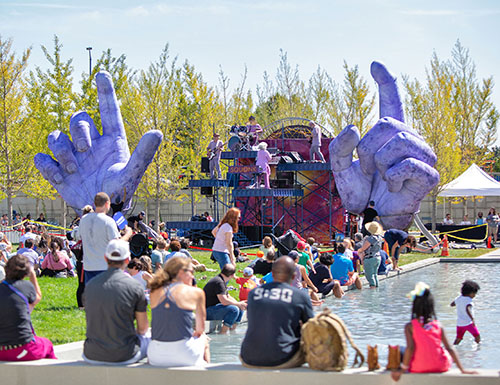
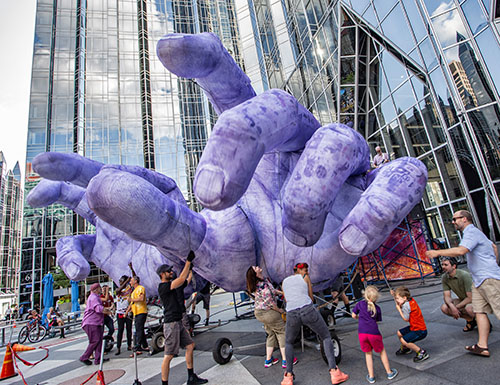
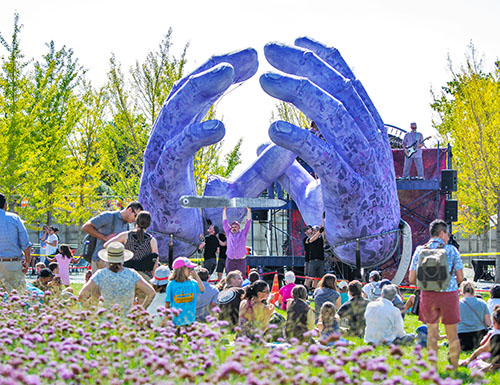
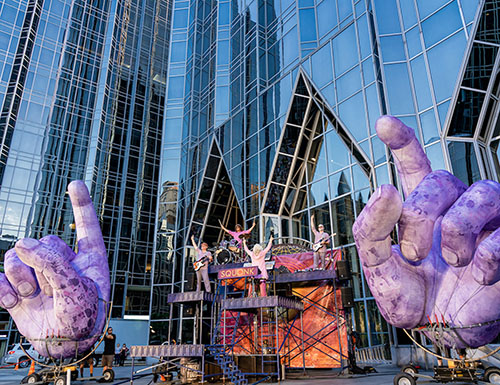
Local, Inclusive and Accessible
Steve is happy to be reopening after a 22-month pandemic hiatus. SQUONK is launching a new series called “SQUONK in the Neighborhood,” which presents SQUONK's original music spectacle to underserved audiences across the greater Pittsburgh region. Attendance is free, and no tickets are required.
“There’s a Pittsburgh-y self-effacement in our shows where the humor is built on how awkward some things are to pull off. The transparency of our show is celebrated. It’s not a magic show. If something you saw was amazing then you saw every step of the way, and you saw the people pushing to make that happen,” Steve says. “In that sense, you can take ownership as a participant. You can say to yourself, ‘I could have thought of that.’ Every viewer has to be creative and must invest their own emotions.”
Both Steve and Jackie think it’s important to bring free shows to underserved communities. While foundations are critical to funding artistic endeavors, it is equally critical to reach people and places who do not benefit from the big cultural institutions. Steve and Jackie also want to empower audiences by offering people the opportunity to construct their own meaning in the nonverbal and non-narrative.
Taking the National Stage
Squonk appeared on “America’s Got Talent” in 2011, which garnered an audience of more than 14 million people.
“We’ve never been famous or part of mass culture, but we’ve always had the instinct to say yes to everything,” Steve says. “It was kind of fun and strange and a very interesting experience.”
Ultimately, their TV appearance reconfirmed SQUONK'S intuition to stay away from mass culture. “We learned the same lesson after moving from an off-Broadway, avant-garde 100-seat theatre in the East Village [where their show was a hit] to Broadway,” he says. “Broadway was clearly the wrong place for us.”
“Making art and getting it out there is not just about succeeding. The art you most learn from are the failures.”
What’s Next?
Squonk recently released their first live CD, the soundtrack of their acclaimed show “Hand to Hand,” and they have started a national tour that included a September 2021 stop at New York City’s Lincoln Center for the Performing Arts, which took place in time for Squonk to usher in its 30th anniversary in 2022.
While Steve’s environmental and theater designs have been recognized with award after award, he’s not doing this type of work for recognition.
